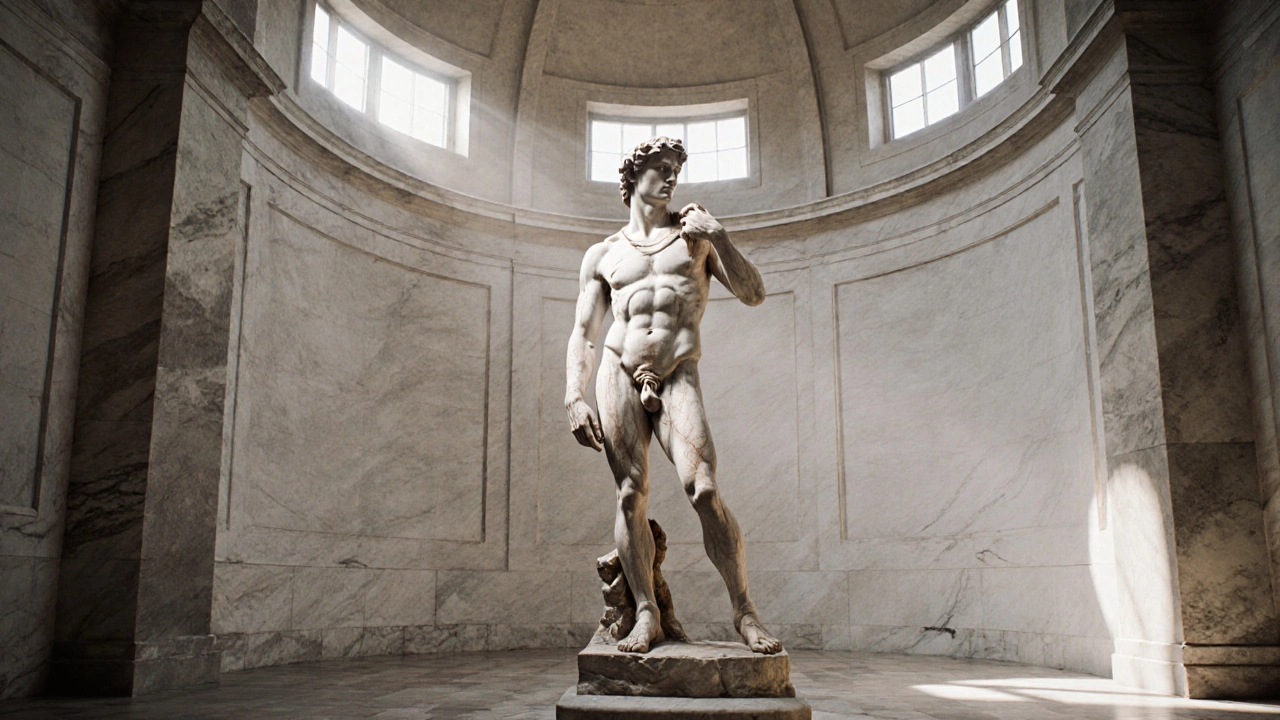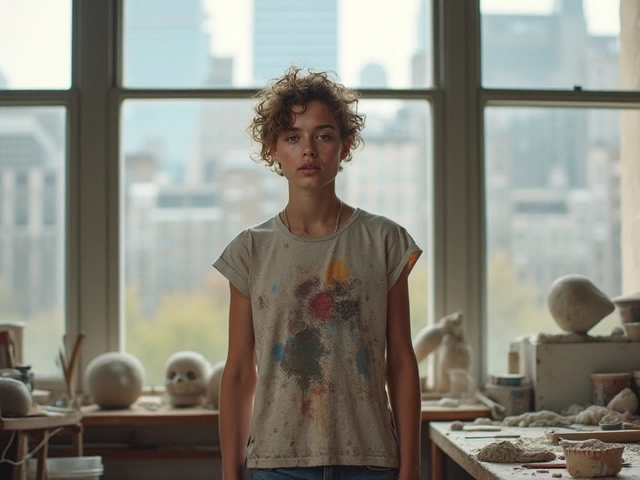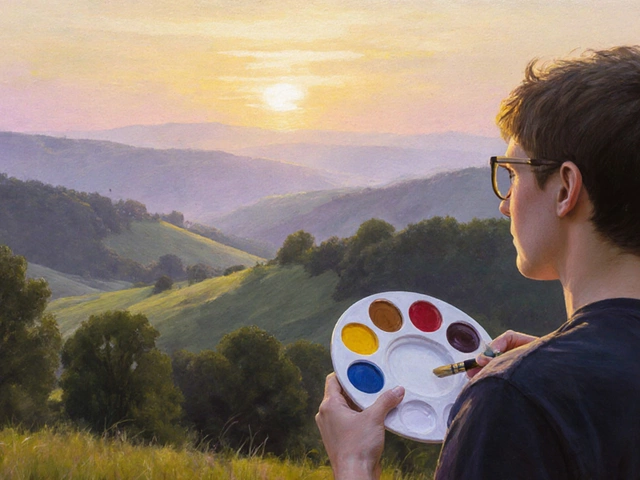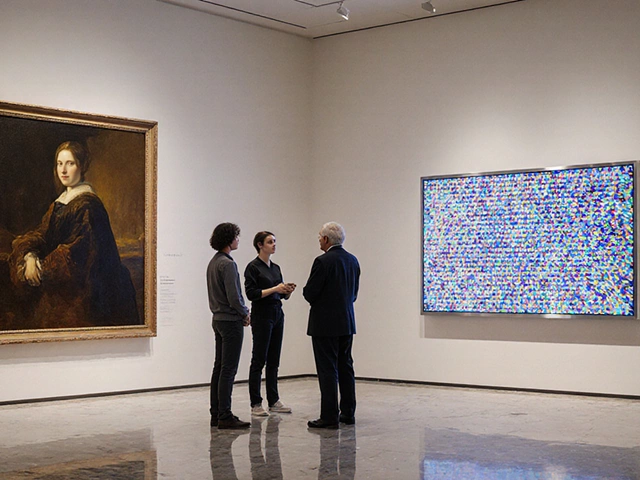Sculpture Comparison Tool
Sculpture Comparison
Compare five iconic sculptures from different eras based on key attributes
David
Michelangelo (1501-1504)
The Thinker
Auguste Rodin (1880)
The Little Dancer
Edgar Degas (1881)
Christ the Redeemer
Ricardo do Villar (1931)
Cloud Gate
Anish Kapoor (2004)
When someone asks, "What is an example of sculpture art?" they’re not just looking for a name. They want to feel it-the weight of marble, the curve of bronze, the way light hits a surface carved by hand centuries ago. Sculpture isn’t just something you see in a museum. It’s something you walk around, touch with your eyes, and remember in your bones.
David by Michelangelo
One of the most recognized examples of sculpture art is David by Michelangelo. Carved from a single block of Carrara marble between 1501 and 1504, this 17-foot-tall statue shows a young man standing calm before battle. Not a warrior in motion, but one in stillness-thinking, ready. The veins in his hands, the tension in his neck, the way his right foot presses into the ground-all of it was chiseled without modern tools. Michelangelo didn’t build David. He released him from the stone.
People often mistake David for a biblical hero in armor. But he’s barefoot, wearing only a sling over his shoulder. He’s not celebrating victory-he’s facing fear. That’s why it still hits hard 500 years later. It’s not just a statue. It’s a human moment frozen in marble.
The Thinker by Auguste Rodin
If David is about potential, then The Thinker is about thought itself. Rodin created this figure in 1880 as part of a larger work called The Gates of Hell. Originally named The Poet, it was meant to represent Dante, deep in contemplation. But over time, it became something bigger: the universal image of a person lost in thought.
The muscles in his arms, the way his chin rests on his fist, the knuckles digging into his skull-it all screams internal struggle. Rodin didn’t smooth the surface. He left tool marks. He made the bronze look alive, like the man inside is still moving. That’s why copies of The Thinker sit outside universities, law firms, and libraries. It’s not decoration. It’s a reminder that thinking is hard work.
The Little Dancer Aged Fourteen by Edgar Degas
Not all sculpture art is about gods, heroes, or philosophers. Sometimes it’s about real people, overlooked and unnamed. The Little Dancer Aged Fourteen, made by Edgar Degas around 1881, shows a young ballet student in a real tutu, with a real ribbon in her hair. Her face is tired. Her posture is stiff. She’s not graceful. She’s working.
Degas used wax, real fabric, and even human hair. It shocked people when it was first shown. Critics called it ugly. But today, it’s one of the most important sculptures of the 19th century. Why? Because it didn’t idealize. It told the truth. This girl wasn’t a fantasy. She was a child laborer in Paris, dancing to survive. Degas didn’t make her beautiful. He made her visible.
Christ the Redeemer
Standing 98 feet tall on a mountain in Rio de Janeiro, Christ the Redeemer is one of the most massive examples of sculpture art ever built. Completed in 1931, it’s made of reinforced concrete and soapstone. The arms stretch wide-not in blessing, but in welcome. You can see it from miles away.
It’s not subtle. It’s not quiet. But that’s the point. It was meant to be seen, not just admired. In a city full of noise and movement, this figure stands still, arms open, overlooking the chaos. It’s religious, yes-but also cultural. It’s a symbol of Brazil, not just Christianity. People climb the mountain not just to pray, but to feel small in the best way possible.
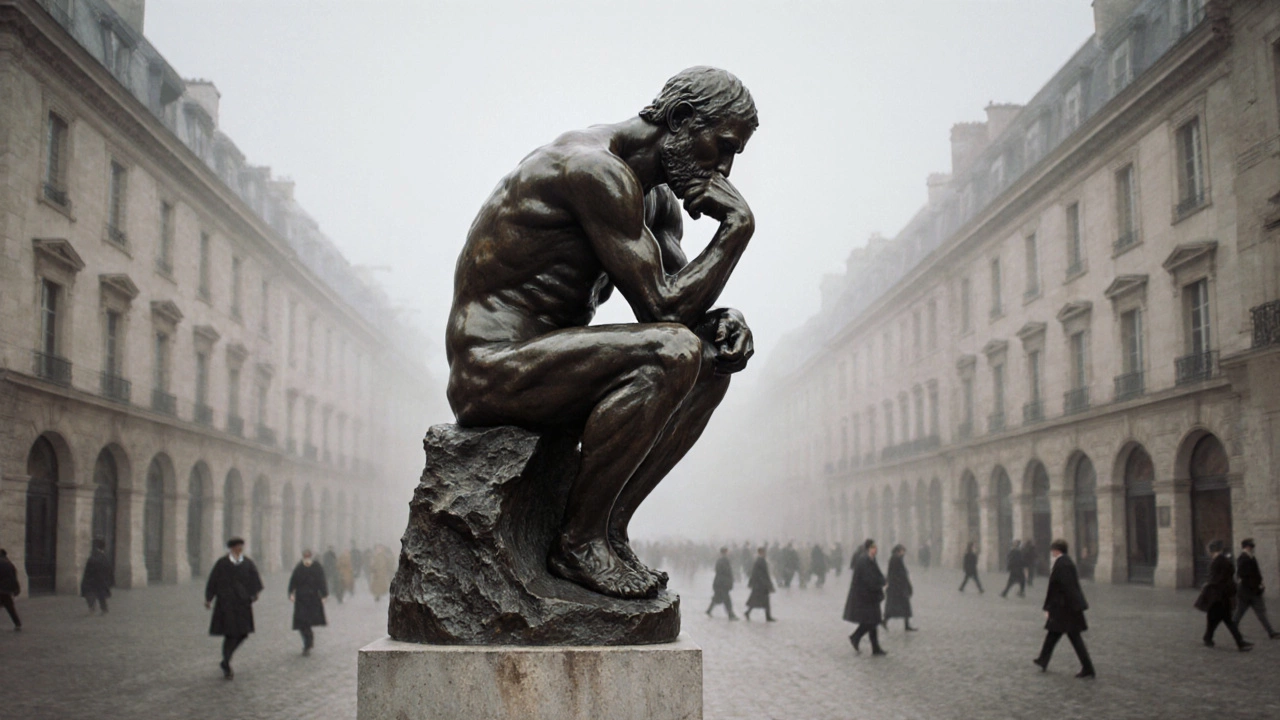
Cloud Gate by Anish Kapoor
Move from the past to the present, and you find Cloud Gate in Chicago’s Millennium Park. Better known as "The Bean," this 110-ton stainless steel sculpture looks like a liquid drop frozen in mid-air. Its surface reflects the skyline, the clouds, and the people walking around it-distorting, stretching, and flipping them.
Unlike David or The Thinker, Cloud Gate doesn’t tell a story. It doesn’t represent a person or an idea. It reflects you. And that’s what makes it powerful. You don’t just look at it. You become part of it. Kids crawl under it. Couples take selfies. Tourists try to figure out how it was made. It’s sculpture that invites participation, not just observation.
Why These Examples Matter
These five works-David, The Thinker, The Little Dancer, Christ the Redeemer, and Cloud Gate-cover more than 500 years of human history. They show how sculpture has changed, but also how it hasn’t. The tools changed. The materials changed. But the goal stayed the same: to make something solid out of something fleeting.
Sculpture art doesn’t need to be big or ancient to matter. A child’s clay handprint on a windowsill is sculpture. A carved wooden spoon passed down through generations is sculpture. What makes it art is the intention behind it-the time, the attention, the choice to turn raw material into meaning.
So when someone asks, "What is an example of sculpture art?" the answer isn’t just one name. It’s the whole range-from Michelangelo’s marble to your neighbor’s garden gnome. It’s the human need to shape the world, not just live in it.
What Makes Sculpture Different From Other Art Forms
Painting sits on a wall. Photography hangs in a frame. But sculpture? It occupies space the same way you do. You can walk around it. Look up at it. Crouch under it. Touch it (if you’re allowed). That physical presence changes everything.
With a painting, you see what the artist wanted you to see-front and center. With sculpture, you get to choose your angle. The shadows shift. The light changes. The form reveals itself slowly. That’s why museums often place sculptures in open rooms, not tucked in corners.
It’s also harder to make. You can’t erase a mistake in marble. Once you cut away, it’s gone. No undo button. That’s why sculptors spend months, sometimes years, on a single piece. They don’t just design. They negotiate with the material.
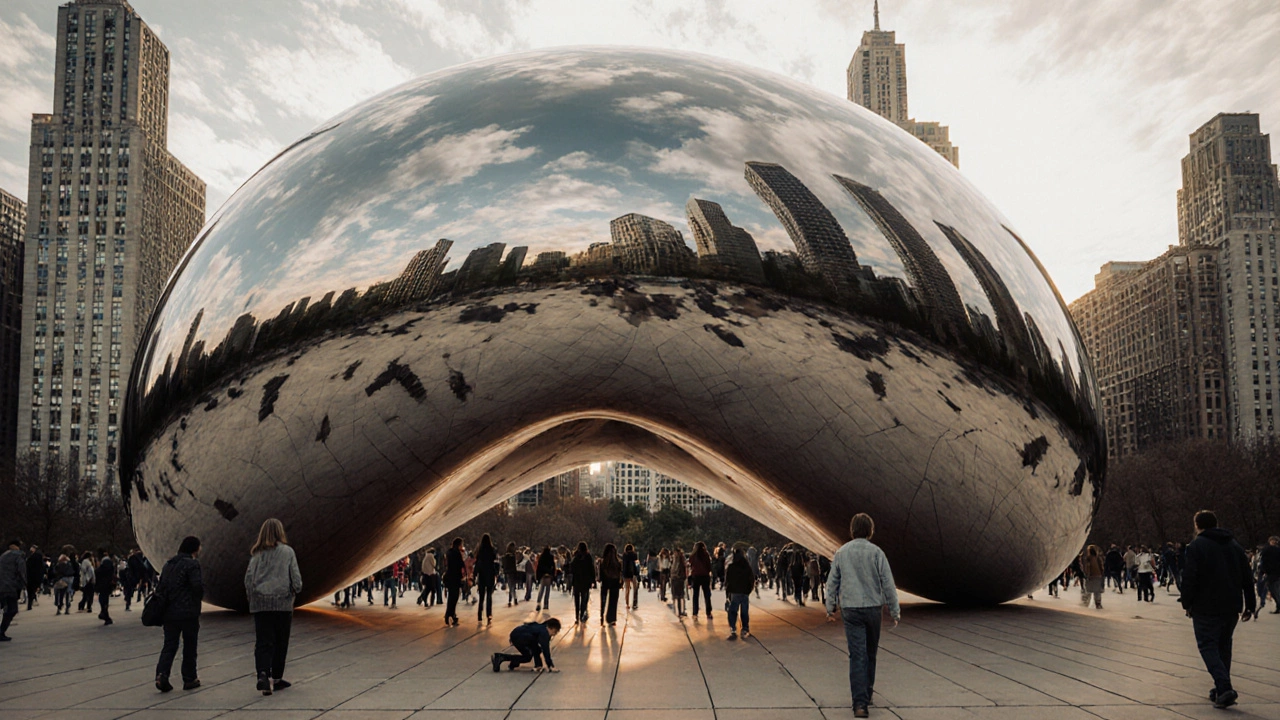
Modern Sculpture: Beyond Stone and Bronze
Today’s sculptors aren’t limited to marble or bronze. They use steel, plastic, glass, even recycled trash. Rachel Whiteread made a sculpture out of the empty space inside a house. Ai Weiwei built a giant sunflower seed installation with 100 million porcelain seeds. Urs Fischer melted a wax copy of a famous statue and let it drip over weeks.
These aren’t just new materials. They’re new questions. Can sculpture be temporary? Can it be made by machines? Can it be made of nothing? The answers aren’t always pretty. But they’re honest.
Where to See Sculpture Art Today
You don’t need to fly to Florence or Paris to experience great sculpture. Many cities have public art programs. Vancouver has over 200 outdoor sculptures, from abstract metal forms to bronze figures of local heroes. New York’s Bryant Park has rotating installations. London’s Trafalgar Square has lions and generals and a giant goose.
Even small towns often have a statue in the town square-a soldier, a founder, a local athlete. These aren’t just decorations. They’re community memory made solid.
If you want to see more, visit university art departments. They often have student shows where sculpture is experimental, raw, and real. Or check out local galleries that focus on 3D work. You might find something that speaks to you-not because it’s famous, but because it feels true.
What is the most famous sculpture in the world?
The most famous sculpture in the world is widely considered to be Michelangelo’s David. It’s recognized globally for its technical mastery, emotional depth, and cultural impact. But fame doesn’t always mean importance-The Thinker, the Venus de Milo, and Christ the Redeemer are also household names, each holding meaning in different cultures and contexts.
Can anything be considered sculpture art?
Yes, if it’s shaped intentionally by an artist to exist in three dimensions. Sculpture isn’t limited to traditional materials like stone or metal. Contemporary artists use ice, light, fabric, food, and even digital models. What matters is the artist’s intent and the viewer’s experience-not the material.
Is a statue always a sculpture?
Most statues are sculptures, but not all sculptures are statues. A statue specifically represents a person or animal in a realistic way. Sculpture is broader-it includes abstract forms, installations, assemblages, and even empty spaces. Cloud Gate isn’t a statue. But it’s still sculpture.
How do you tell if a sculpture is valuable?
Value comes from several things: the artist’s reputation, the rarity of the piece, its historical importance, and its condition. A small bronze by Rodin can be worth millions, while a mass-produced replica might be worth $20. Provenance-knowing who owned it and where it’s been-also matters. But emotional value? That’s personal. A child’s first clay pot might be priceless to a family.
Can sculpture be digital?
Yes. Digital sculptures are created using 3D modeling software and can be printed in physical form using 3D printers. Some artists only show their work as virtual files or in augmented reality. The material doesn’t define the art-the idea and the experience do. Digital sculpture is still sculpture, just made with code instead of chisels.
Where to Go From Here
Next time you’re walking through a park, look down. Look up. Look around. You might spot a sculpture you never noticed before. Maybe it’s a weathered figure holding a book. Maybe it’s a twisted metal shape that catches the sunset. Don’t ask if it’s famous. Ask what it makes you feel.
Sculpture doesn’t need to be perfect. It doesn’t need to be old. It just needs to be real. And once you start seeing it, you’ll realize it’s been there all along-waiting for you to walk around it, and finally, to see it clearly.
